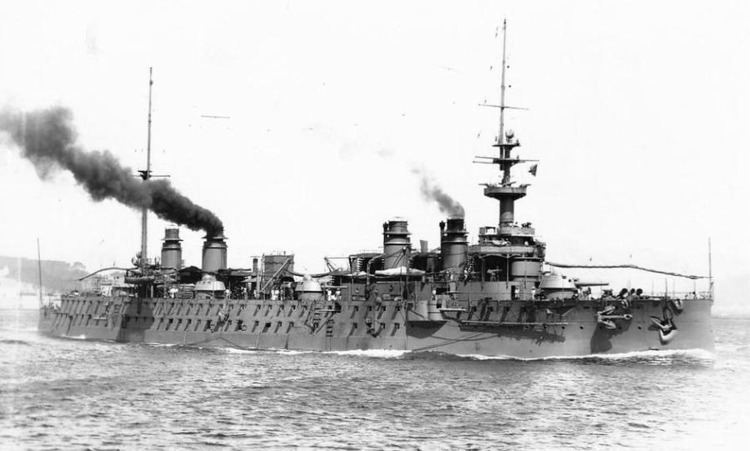Name Gloire Laid down 5 September 1899 Fate Scrapped, 1922 Launched 27 June 1900 Weight 10,210 tons Builder DCNS | Commissioned 1904 Construction started 5 September 1899 Length 140 m Displacement 10.21 million kg | |
 | ||
Class and type Gloire-class cruiser armored cruiser | ||
The French cruiser Gloire was one of five Gloire-class armored cruisers built for the French Navy in the first decade of the 20th century. She served in the English Channel and the Atlantic as a convoy escort during World War I.
Contents
Design and description
The Gloire-class ships were designed as enlarged and improved versions of the Gueydon-class armored cruisers by Emile Bertin. Her crew numbered 612 officers and enlisted men. The ship measured 139.8 meters (458 ft 8 in) overall, with a beam of 20.2 meters (66 ft 3 in). Gloire had a draft of 7.7 meters (25 ft 3 in) and displaced 10,212 metric tons (10,051 long tons).
The ship had three vertical triple-expansion steam engines, each driving one propeller shaft. The engines were rated at a total of 20,500 indicated horsepower (15,300 kW), using steam provided by 28 Niclausse boilers. She had a designed speed of 21.5 knots (39.8 km/h; 24.7 mph). She carried up to 1,590 long tons (1,620 t) of coal and could steam for 12,000 nautical miles (22,000 km; 14,000 mi) at a speed of 10 knots (19 km/h; 12 mph).
Gloire's main armament consisted of two 194-millimeter (7.6 in) guns were mounted in single gun turrets fore and aft. Her intermediate armament was eight Canon de 164 mm Modèle 1893 guns. Four of these were in single gun turrets on the sides of the ship and the other four were in casemates. For anti-torpedo boat defence she carried six 100-millimeter (3.9 in) guns in casemates and eighteen 47-millimeter (1.9 in) Hotchkiss guns. She was also armed with five 450-millimeter (17.7 in) torpedo tubes; two of these were submerged and the others were above water.
The waterline armored belt of the Gloire-class ships was 170 millimeters (6.7 in) thick amidships and tapered to 106 millimeters (4.2 in) towards the bow and stern. Above the main belt was a thinner strake of armor, 127 millimeters (5 in) thick that also tapered to 106 mm at the ends of the ship. The conning tower had armored sides 150 millimeters (5.9 in) thick. The main gun turrets were protected by 173 millimeters (6.8 in) of armor and the intermediate turrets by 120 millimeters (4.7 in). The flat part of the lower armored deck was 45 millimeters (1.8 in), but increased to 64 millimeters (2.5 in) as it sloped down to the sides of the ship.
Construction and career
Gloire, named after Glory, was laid down at the Arsenal de Lorient on 10 January 1900, launched on 14 July 1900, and completed on 28 April 1904. When World War I began, the cruiser was assigned to the Training Squadron which reinforced the 2nd Light Squadron at Brest. She patrolled the English Channel into 1915, before she was transferred to the Caribbean and Atlantic for convoy-escort duties. In May 1918, Gloire collided with the American liner SS City of Athens. The ship was stricken in 1922 and scrapped in 1928.
